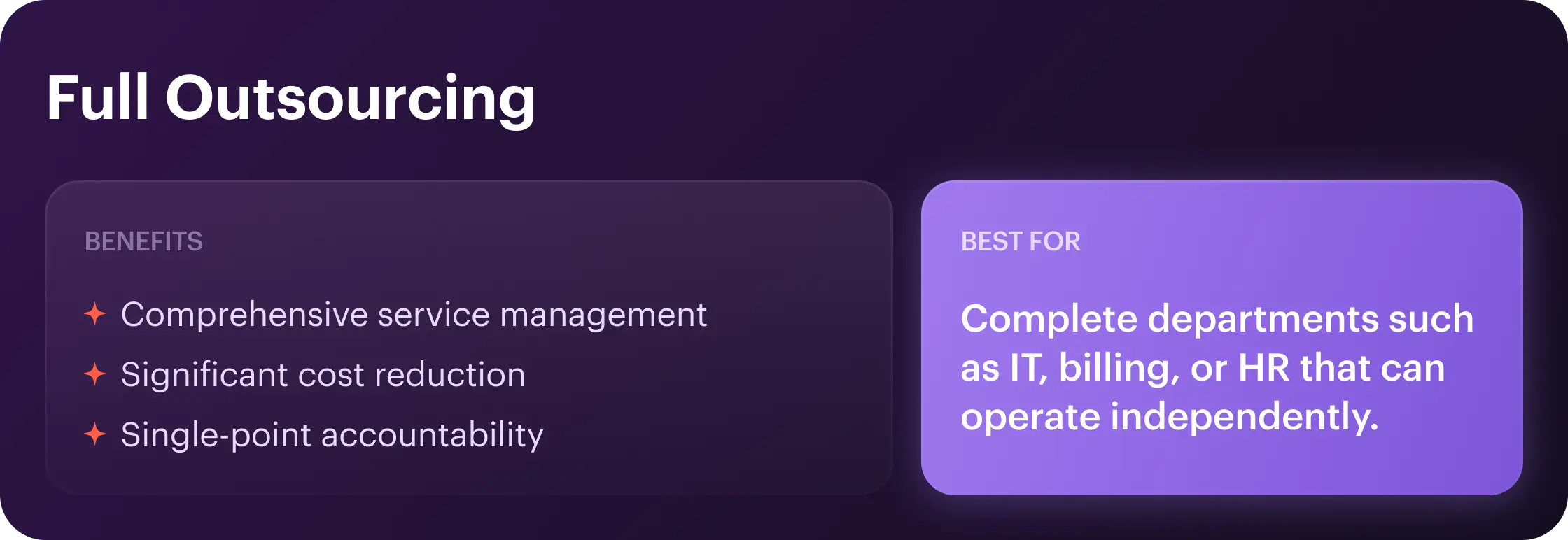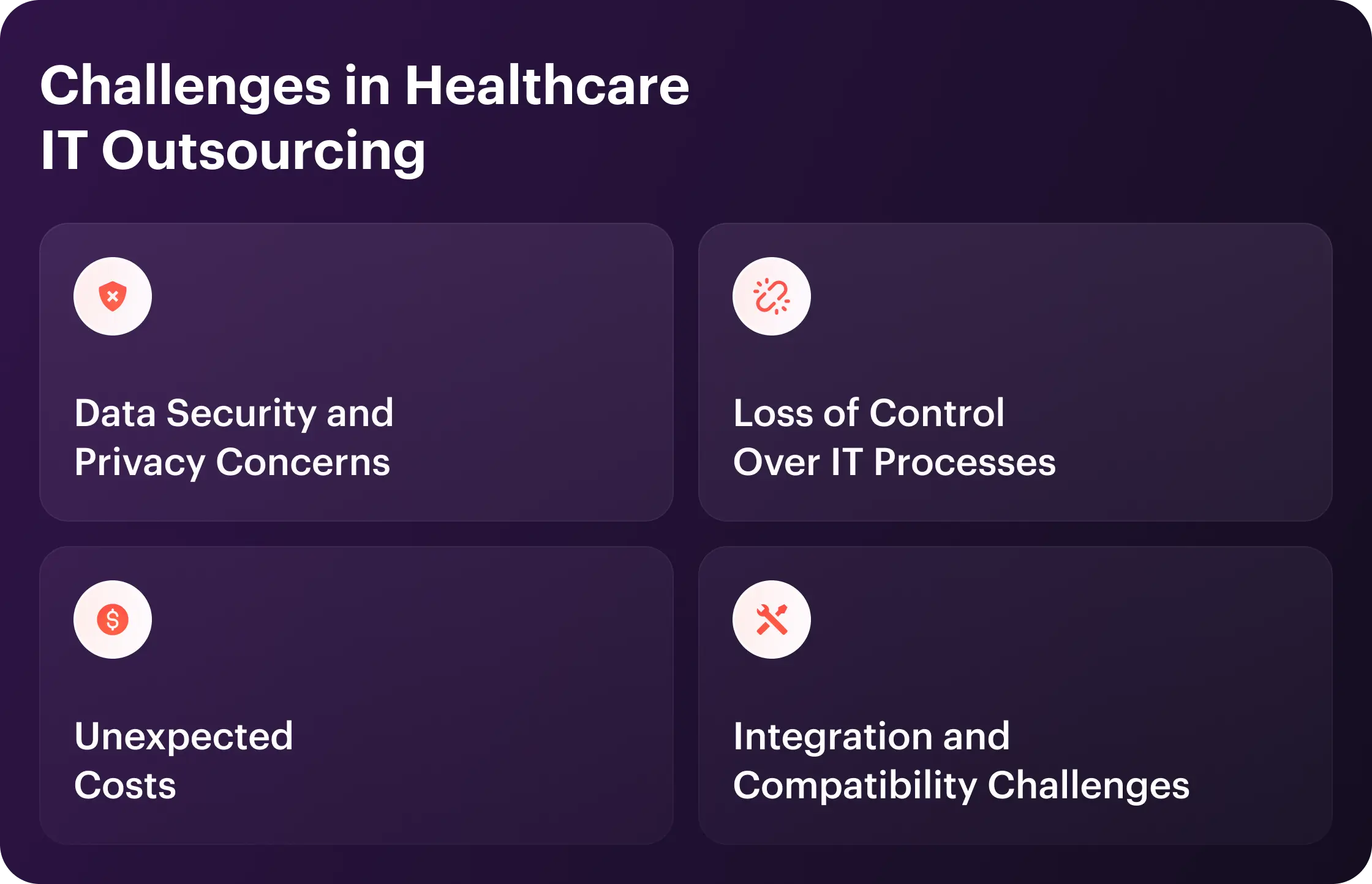Healthcare IT Outsourcing: A Comprehensive Guide

Over 70% of healthcare providers rely on outsourced IT solutions and specialists to manage their technology infrastructure. As modernization grows more complex—internal teams often struggle to keep up with evolving demands to handle modern IT demands, such as cloud computing, interoperability, and security.
When there's a lack of expertize, deadlines often get pushed back, and tech infrastructure quality drops (business outcomes hinders too).
In short, healthcare's digital shift requires speed and security. That is where healthcare software development outsourcing delivers, whereas internal can't.
Outsourcing brings specialized expertise, cost efficiency, and regulatory compliance (HIPAA, GDPR) while enabling scalable growth. This guide breaks down everything you need to know—what healthcare software outsourcing is, its benefits and drawbacks, how to implement it effectively, and what it costs. Let's dive in.
Healthcare IT Outsourcing Market in 2025: Key Trends and Growth Drivers
Healthcare IT outsourcing has become a cornerstone of the healthcare industry's digital transformation, with the global market projected to grow from $60.6B in 2025 to $117.1 billion by 2035 at a compound annual growth rate (CAGR) of 6.8%. This growth is driven by the increasing demand for cost-efficient, scalable, and innovative IT solutions that address operational challenges, improve patient outcomes, and reduce costs.
Key trends in healthcare IT outsourcing in 2025 are:
Integration & Interoperability
- API/IoT integration for EHR interoperability | Secure FHIR-compliant data exchange | Unified "Super Apps" for telehealth/diagnostics.
AI & Custom Solutions
- AI/ML diagnostics & HIPAA-compliant apps | Modular MVPs for healthtech startups | Blockchain-secured data analytics.
Cross-Platform Agility
- Hybrid apps/PWAs with wearables/IoT sync | Device-agnostic apps with secure data sync | Cloud-EHR integration for telehealth.
Automation
- End-to-end workflow automation (appointments, billing) | AI chatbots for triage | Predictive staffing/resource tools.
Analytics & Dashboards
- Real-time patient tracking with predictive analytics | Custom KPI dashboards (compliance, efficiency) | Role-based mobile insights/alerts.
North America leads the market regionally due to its advanced health infrastructure and regulatory environment, followed by Europe and Asia-Pacific.
What is IT Outsourcing in Healthcare
Outsourcing healthcare IT means organizations hire external firms to manage their IT needs. This allows providers to focus on patient care while specialists handle EHR management, network support, software development, cybersecurity, and billing tasks. The approach cuts costs, delivers expert skills, scales with demand, and ultimately improves patient outcomes.
How Does Healthcare IT Outsourcing Work?
Healthcare IT outsourcing starts with identifying which functions need external support, such as custom-built healthcare hardware integrations, EHR management, cybersecurity, or medical billing automation, integration with cloud-based health records and data analytics platforms, custom hardware solutions for telehealth and remote monitoring. Providers then choose a partner based on expertise, security standards, and regulatory compliance. A contract outlines services, security protocols, and performance expectations.
Next comes implementation, where the outsourcing team handles data migration, system integration, and staff training with minimal disruption. Once in place, they provide ongoing support, security monitoring, and compliance audits.
As healthcare organizations grow, outsourced IT services scale with them, expanding telehealth, strengthening security, and optimizing operations. The result? Lower costs, greater efficiency, and more focus on patient care.
Why Do Healthcare Providers Need IT Outsourcing
It is pretty time-consuming for healthcare service providers to go deep into healthcare information technology. Hiring in-house IT experts for long-term projects can be difficult and frustrating. Here's why:
Reduced Time-To-Market.
In healthcare, the rapid deployment of new technologies can significantly impact patient care. Outsourcing to specialized IT providers allows for faster implementation of telehealth platforms, patient portals, and electronic health record (EHR) systems. This speed is crucial in a rapidly evolving healthcare landscape.
This also means that new regulatory changes that require IT implementation can be implemented much faster, keeping the healthcare providers in compliance.
No Tech Skills Required.
Healthcare professionals are experts in patient care, not necessarily in IT. Outsourcing eliminates the need for extensive in-house IT expertise. This allows medical staff to focus on their core competencies while relying on external experts to manage complex IT systems.
Also, this is a great solution for the shortage of qualified IT professionals.
HIPAA Compliant End Product.
Security and privacy must come first in healthcare. IT outsourcing providers specializing in healthcare are well-versed in HIPAA regulations and can ensure that all IT solutions meet stringent compliance standards. This reduces the risk of costly data breaches and legal penalties.
This also reduces the burden of in-house IT staff to keep up with the ever-changing HIPPA regulations.
Lower Development Budget.
Maintaining an in-house IT department can be expensive. Outsourcing allows healthcare providers to access specialized IT services without the overhead costs of salaries, benefits, and equipment. This can significantly reduce operational expenses, freeing resources for other critical areas.
In essence, outsourcing allows for predictable IT costs.
Shorter Recruitment Process.
Hiring and retaining qualified IT professionals can be challenging, especially in the competitive healthcare market. Outsourcing eliminates the need for lengthy recruitment processes, allowing healthcare providers to access the IT expertise they need quickly. Plus, avoiding additional full-time hires can save $100K+ per senior developer per year, while reducing reliance on in-house hiring lowers operational costs by 28%.

Key Healthcare IT Functions You Can Outsource
With rising IT demands, healthcare providers offload tech-heavy tasks to external partners. Outsourcing medical mobile app development, billing software, integration of third-party healthcare services and APIs—ensures agility, compliance, and operational efficiency. Thus, healthcare representatives could focus on what matters most—patient care. Let’s talk in detail about these services:
Medical Billing and Coding Software
Managing medical billing in-house is complex and error-prone. Outsourcing to specialized vendors improves accuracy and accelerates claims processing. This helps reduce billing errors and ensures timely reimbursement. Some companies offer cloud-based medical billing services that automate billing procedures and enhance revenue cycle management.
Telemedicine and Remote Patient Monitoring Solutions
Patients expect remote consultations, digital check-ins, and real-time health monitoring. Developing these solutions in-house is challenging, so many healthcare providers outsource telemedicine and remote monitoring. This expands care access, improves chronic disease management, and ensures HIPAA-compliant, user-friendly platforms.
IT Infrastructure Management
Healthcare providers depend on reliable IT infrastructure for operations, data storage, and security. Outsourcing simplifies maintenance, cuts costs, and ensures scalability as organizations grow. By delegating IT tasks, providers can prioritize patient care without technical concerns.
Benefits of Outsourcing in Healthcare
There's no doubt that outsourcing is reshaping healthcare. It optimizes workflows, lowers costs, and improves care quality from hospitals to labs. Here’s a detailed outlook on how each sector gains:
Benefits of Medical Centers and Hospital IT Outsourcing
From IT services to administrative tasks, outsourcing allows hospitals to focus on patient care while reducing expenses. Read on for details on the benefits of this type of outsourcing:
Cost Optimization and Resource Management
- Reduction in operational expenses through outsourced administrative tasks.
- More efficient allocation of medical staff to core patient care activities.
- Lower infrastructure and technology investment costs.
Enhanced Focus on Patient Care
- Medical professionals can dedicate more time to patient interaction and treatment.
- Improved patient satisfaction through faster service delivery.
- Better management of patient records and documentation.
Access to Specialized Expertise
- Ability to tap into specialized medical professionals without full-time hiring.
- Access to the latest medical technologies without significant capital investment.
- Specialized training and development programs for staff.
Benefits of Outsourcing for Healthtech Startups
Scaling a health tech startup with tight budgets, evolving regulations, and rapid tech advancements is challenging. Outsourcing offers a cost-effective way to access expertise, accelerate growth, and stay competitive. Here’s how it makes a difference.
Rapid Scaling Capabilities
- Faster market entry through ready-to-deploy solutions.
- Ability to scale operations up or down based on market demand.
- Reduced time-to-market for new healthcare solutions.
Technology Implementation
- Access to experienced development teams for healthcare applications.
- Integration of emerging technologies like AI and IoT.
- Compliance with healthcare regulations and standards.
Cost-Effective Innovation
- Reduced R&D expenses through shared resources.
- Access to global talent pools for specialized development.
- Lower operational costs during the crucial growth phase.
Benefits of Outsourcing for Veterinary Clinics
From appointment scheduling to IT management, veterinary clinics can benefit greatly from outsourcing. It reduces workload, improves efficiency, and allows vets to dedicate more time to their patients. Here are details on the benefits:
Operational Efficiency
- Streamlined appointment scheduling and patient management.
- Automated billing and insurance processing.
- Efficient inventory management for medical supplies.
Extended Service Capabilities
- 24/7 emergency support through outsourced services.
- Access to specialized veterinary consultants.
- Enhanced diagnostic capabilities through remote services.
Business Growth Support
- Marketing and client relationship management.
- Financial planning and analysis.
- Staff training and development programs.
Benefits of Outsourcing for Pharmaceutical Companies
With rising production costs and complex regulatory requirements, pharmaceutical companies are turning to outsourcing for efficiency, compliance, and faster innovation. More benefits are listed below:
Research and Development
- Access to specialized research facilities and equipment
- Collaboration with global research teams
- Faster clinical trial processes and data management
Manufacturing and Quality Control
- Cost-effective production through contract manufacturing.
- Stringent quality control processes.
- Flexible production capacity management.
Market Access and Distribution
- Global distribution network access.
- Local market expertise in different regions.
- Regulatory compliance management.
Benefits of Outsourcing for Medical Device Manufacturers
From prototyping to full-scale production, outsourcing enables medical device manufacturers to access specialized expertise, reduce operational costs, and focus on core innovations. Here’s how it drives efficiency and growth.
Design and Engineering
- Access to specialized product design expertise.
- Rapid prototyping capabilities.
- Cost-effective research and development.
Production Optimization
- Flexible manufacturing capabilities.
- Quality assurance and compliance.
- Supply chain management.
Benefits of Outsourcing for Medical Laboratories
From sample processing to data security, outsourcing allows medical laboratories to streamline operations, reduce expenses, and enhance service quality. Here’s why it’s a strategic move.
Testing Capabilities
- Expanded test menu through partnerships.
- Advanced equipment access without capital investment.
- Specialized testing expertise.
Data Management
- Efficient lab information systems.
- Secure patient data handling.
- Integration with healthcare providers.
Benefits of Outsourcing for Healthcare Insurance Providers
Managing healthcare insurance operations requires speed, accuracy, and compliance. Outsourcing allows providers to reduce overhead, scale operations, and enhance customer satisfaction. Here’s how it benefits the industry.
Claims Processing
- Faster claims adjudication.
- Reduced processing costs.
- Better fraud detection.
Customer Service
- 24/7 support availability.
- Multi-language capabilities.
- Improved response times.
How to Find Out If You Need Healthcare IT Outsourcing
While the benefits of healthcare IT outsourcing are endless, what are the signs that healthcare organizations need to switch to this model? Here are the key indicators:
- ROI is the name of the game. More hospitals turn to outsourcing to lower expenses, with nearly 90% of healthcare companies reporting positive returns in just three months or less.
- Immediate access to skilled teams and technology. Technology is advancing fast, making it hard for hospitals to find and keep IT staff, especially in rural areas. Many turn to third-party providers for hosting, network management, help desk support, application support, and IT outsourcing. These services can be done on-site, remotely, or both.
- Cyber security threads. Many organizations outsource security because in-house teams can’t keep up with evolving threats. Additionally, new security technologies are expensive, while outsourcing spreads costs across multiple clients.
- The gap in strategic IT leadership. As technology reshapes healthcare, strong IT leadership is more critical than ever. Once a back-end support role, IT now drives hospital strategy, yet many facilities—especially in smaller communities—struggle to fill C-suite positions. Leading outsourcing firms bridge this gap, providing experienced IT executives who align technology with hospital goals.
- Let the hospital IT staff focus on key tasks. IT outsourcing shifts hospital IT teams from routine maintenance to high-impact projects, allowing leadership to focus on core healthcare priorities.
- Organizational crisis. When IT issues put patient care at risk, hospitals must act fast, often relying on third-party experts. When it happens, you won’t have to guess.
What Is the Best Healthcare Outsourcing Model for Your Business
There’s no one-size-fits-all answer; the best healthcare outsourcing model depends on your organization’s priorities.
Full Outsourcing
Full outsourcing transfers entire non-core functions to an external provider. You let the vendor handle day-to-day operations while focusing on your core business. This model is ideal for organizations seeking major cost savings and streamlined operations.
Benefits:
- Comprehensive service management
- Significant cost reduction
- Single-point accountability
Best for: Complete departments such as IT, billing, or HR that can operate independently.

Selective Outsourcing
Selective outsourcing lets you outsource specific tasks while keeping essential functions in-house. You benefit from specialized skills without giving up full control over key processes. This model works well for companies looking to optimize certain operations without overhauling their entire structure.
Benefits:
- Focused expertise for targeted tasks
- Retained control over critical processes
- Flexibility in managing workload
Best for: Non-core tasks like data processing, administrative work, or technical support.

Hybrid Outsourcing
Combines onshore and offshore services to balance cost, quality, and flexibility. You maintain local oversight for crucial functions while outsourcing routine tasks to cost-effective teams abroad. This model offers the best of both worlds: quality control and cost efficiency.
Benefits:
- Balanced cost savings and quality
- Flexible resource allocation
- Access to global talent pools
Best for: Organizations that need both local management and international cost advantages.

RPO (Recruitment Process Outsourcing)
Use specialized agencies for staffing needs, streamlining the hiring process. You streamline hiring and gain access to a broader talent pool while reducing the administrative burden on your HR team. This model is especially beneficial for organizations looking to fill specialized roles fast.
Benefits:
- Faster, more efficient hiring
- Access to expert recruitment strategies
- Reduced HR workload
Best for: Rapid staffing needs, especially for specialized healthcare roles.

By assessing your business goals, budget, and desired level of control, you can choose the model that best fits your needs.
Common Challenges in Healthcare IT Outsourcing and Strategies to Overcome Them
Healthcare IT outsourcing benefits abound, yet risks loom. Data security, communication gaps, and control loss threaten progress. HHM Global details these pitfalls and offers actionable solutions. Smart outsourcing means mitigating risk, not ignoring it.
Data Security and Privacy Concerns
Healthcare IT systems store sensitive patient data that must comply with strict regulations (e.g., HIPAA). Outsourcing increases the risk of data breaches or unauthorized access if security measures are not robust.
Solutions:
- Implement end-to-end encryption and secure VPNs.
- Enforce rigorous vendor compliance and conduct regular security audits.
- Adhere to healthcare-specific compliance standards, such as SOC 2, HIPAA, or ISO 27001.
- Use multi-factor authentication and strict access controls.
- Ensure the vendor adheres to industry standards for data protection.
Pro Tip: Cybersecurity must be a core part of the contract. Specify required security measures, audits, and breach response plans.
Loss of Control Over IT Processes
Outsourcing IT functions may reduce an organization’s direct oversight over critical processes, potentially leading to slower response times for issue resolution or misalignment with internal standards.
Solutions:
- Define comprehensive Service Level Agreements (SLAs) with measurable performance metrics.
- Set up remote monitoring and regular performance reviews.
- Establish clear governance structures and escalation procedures.
Integration and Compatibility Challenges
Integrating diverse healthcare IT systems can lead to data inconsistencies and operational disruptions, hindering seamless workflows and patient care.
Solutions:
- Conduct thorough compatibility assessments before implementation to identify potential conflicts.
- Utilize middleware or Application Programming Interfaces (APIs) to bridge gaps between disparate systems.
- Establish transparent data migration and integration protocols, ensuring data integrity during transitions.
- Standardize data formats across systems to facilitate seamless data exchange.
- Perform comprehensive testing of all integrations in a simulated environment before going live.
- Develop a well-documented integration plan and have a rollback strategy.
Unexpected Costs
One of the reasons organizations turn to outsourcing is to save on costs. However, unexpected expenses can arise if the scope of work isn’t clearly defined. You can also face this challenge if there are hidden fees for additional services like after-hours support or data migrations.
Solutions:
- Conduct a detailed cost analysis, including potential hidden fees and variable expenses.
- Establish clear and comprehensive contracts with fixed pricing or well-defined variable costs.
- Implement regular budget reviews and track expenses against projected costs.
- Include contingency clauses in the contract to address unexpected expenses.
- Request detailed breakdowns of all costs, and avoid vague pricing structures.
- Develop a strong change management process to control scope creep.
Pro Tip: Always plan for the unexpected by setting aside a contingency budget for unforeseen costs, such as additional security measures or system upgrades that might become necessary during the project.
Solutions:
- Establish clear and consistent communication channels, including regular meetings, email updates, and project management tools.
- Define specific roles and responsibilities for both internal and external teams.
- Implement a centralized communication platform for seamless information sharing.
- Conduct regular training sessions to improve communication skills and cultural awareness.
- Establish a clear escalation process for addressing communication issues.
- Foster a collaborative environment through team-building activities and shared goals.

How to Outsource Healthcare Software Development
Healthcare IT outsourcing is a one-stop solution for organizations that want to cut costs and drive operational efficiency through the latest tech trends. Scorching numbers here: Business operations that outsource their non-core tasks reduce costs by up to 30%.
The development process kicks off once you choose a healthcare IT vendor that aligns with your needs and budget. First, you establish contract, your request is sent to the Business Development Department. Within 24 hours, a manager with healthcare knowledge will reach out to discuss the next steps. If necessary, an NDA can be signed to ensure confidentiality.
In the next phase, the team clearly views the project's goals, scope, and main issues. To refine the plan and go over quality attributes, the outsourced healthcare team sets up a meeting with a solution architect, business analyst, and designer.If there are uncertainties, the team can arrange additional meetings.
Once everything is clear, the team provides a rough estimate and timeline. Next is the discovery phase. This phase outlines the software's visual concept and key features, identifies potential risks, and sets the business strategy. Finally, it refines timelines and cost estimates.
Development and quality assurance are the most intensive stages. The software architecture often starts with a Minimum Viable Product (MVP), which helps validate the idea and collect user feedback. At this stage, development happens in sprints, with each cycle defining specific tasks and objectives. A PM oversees whether the process runs smoothly and tracks any changes or extra requirements that arise. QA engineers test the software carefully. They find and report issues, which developers then fix quickly.
Once development is complete, the software is launched in a healthcare system or a specific marketplace, like Google Play or the App Store. QA remains involved during this phase to verify performance and address last-minute issues. The final stage is ongoing support and maintenance. Even after release, the team continues to monitor the software to ensure functionality, compliance, and competitiveness.
Some updates may include code optimization, integration of modern technologies, and bug fixes to enhance user experience and system performance. This structured approach streamlines and efficiently develops healthcare software.
Want to streamline healthcare IT operations? Darly Solutions is a trusted partner that understands your industry's challenges. Contact us to discover customized solutions that keep your IT systems efficient and secure.
Darly Solutions' Experience in Healthcare IT Outsourcing
At Darly Solutions, we have all the necessary expertise and hands-on experience in creating modern healthcare solutions:
Service Portfolio:
- Custom software development
- App Development
- Cross-platform development
- Automation services
- UI/UX Design
- Integration services
If you need an expert IT team based on managed IT or project augmentation services to partner with you, contact Darly Solutions today to outsource your software development to us!
Wrapping Up
Healthcare organizations are increasingly outsourcing IT functions to reduce costs and enhance efficiency. For instance, hospitals can save substantially by outsourcing electronic medical records systems, freeing up resources for patient care. This trend is further supported by the ability to access specialized cybersecurity and regulatory compliance expertise. Maximize healthcare efficiency with professional IT outsourcing—no time for mediocrity!
FAQ
Ultimately, the best location depends on balancing cost, quality, security, and regulatory requirements. Yet, India and the Philippines are top choices due to their skilled workforce, competitive pricing, and compliance with global healthcare standards. The U.S. and Canada are preferred for onshore outsourcing when strict HIPAA compliance and minimal time zone differences are priorities.
Healthcare providers outsource IT services to reduce costs, access specialized expertise, and allow internal teams to focus on patient care. External partners offer advanced cybersecurity, seamless integration, and regulatory compliance. This strategy helps organizations remain agile and competitive in a rapidly evolving digital landscape.
The cost of healthcare IT outsourcing varies based on services and provider expertise. In the U.S., hiring individual developers can cost up to $850 per hour, but outsourcing to a dedicated team can reduce expenses by up to 30%.
Connect with us
.webp)
We are a tech partner that delivers ingenious digital solutions, engineering and vertical services for industry leaders powered by vetted talents.


.webp)

.webp)
.webp)


